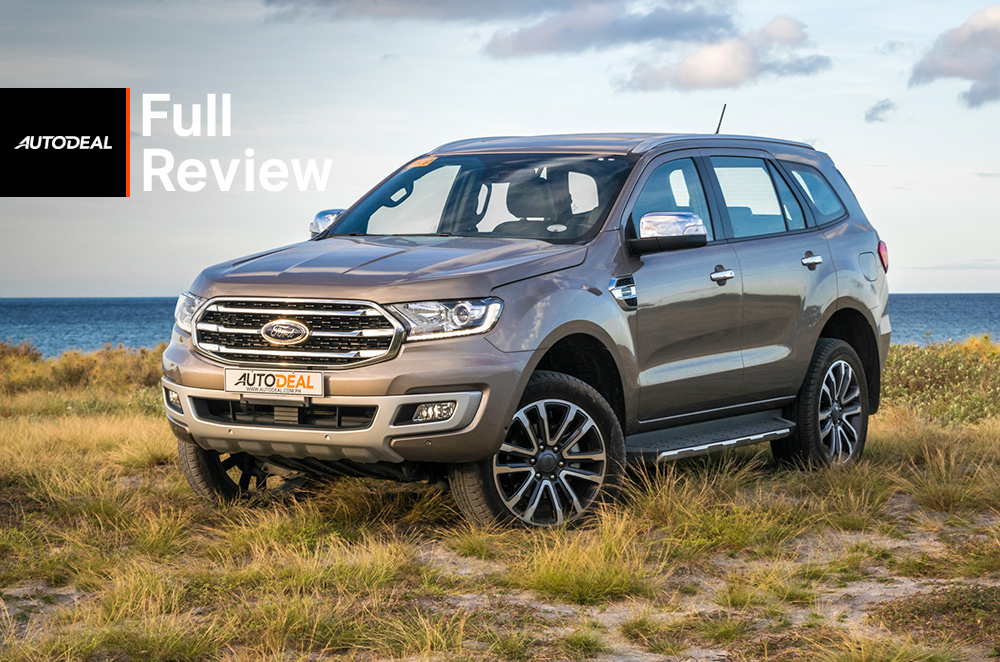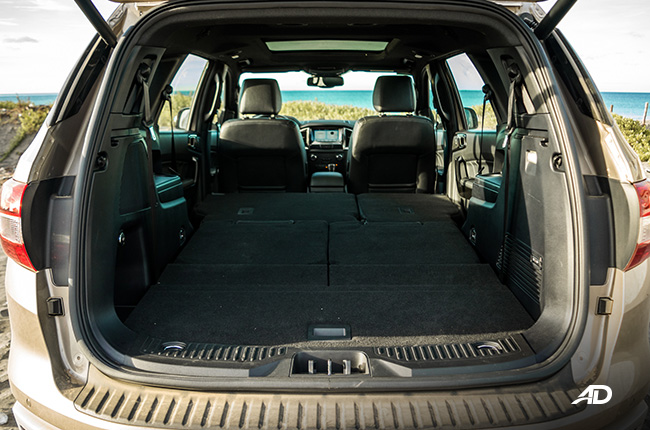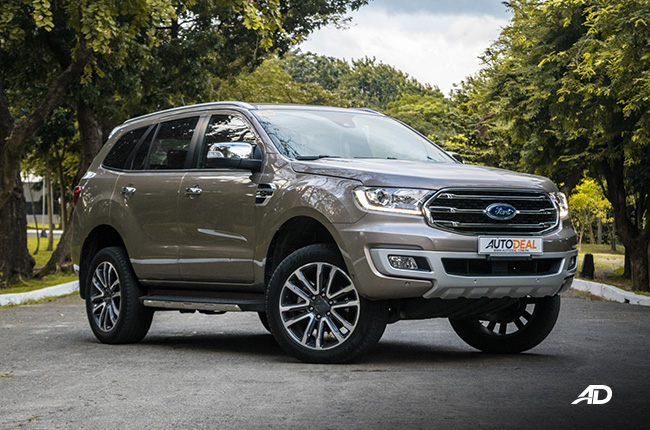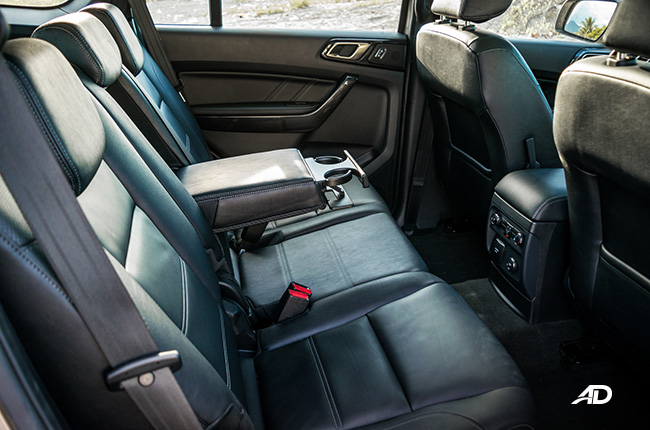
Contents
If there’s any midsize SUV out there that reeks status and prominence, it’s probably the Ford Everest. Even current SUV owners saw the Everest as something they'll buy if money is just an object, while not crossing the bounds of luxury options or even bigger full-size SUVs. It's the SUV that many aspire to climb up to, backed up by its slew of features and imposing looks.
Problem is, ever since the first Everest came here in the Philippines, its rivals have caught up with it in several aspects, which left Ford with no choice but to rekindle its position in the market.
So, how do you reinvent a proven SUV template in just a facelift? Ford opted to change its powertrain and added even more tech while keeping its beefy appeal. But is it enough? I got to test the 2020 Ford Everest 4x4 Biturbo Titanium trim to find out.
Engine Output (HP), Acceleration, Transmission, Handling 4.0/5
Exterior & Interior Design, Quality, Fit and Finish, Ergonomics 4.5/5
Cabin Comfort, Suspension, NVH Insulation 4.5/5
Convenience Technologies, Active and Passive Safety Features 4.5/5
Amount of the vehicle you get for the price, Fuel Efficiency 4.0/5
- Slew of tech and safety features offered in the top-spec trim.
- Pliant yet composed suspension setup.
- Better fuel consumption than its predecessor.
- Non-tumbling second row makes for a challenging third-row ingress/egress.
- Foot-activated tailgate works intermittently.
- Heaving engine sound always penetrates the cabin.
Exterior
I did mention that the new Everest is just a facelift, right? Don’t expect phenomenal design changes in the Blue Oval’s midsize SUV. The deviations aren’t revolutionary, and that’s a good thing. A new three-slat grille, redesigned 20-inch alloys, and a full set of LEDs are enough to let you know that this is a new model. It works for the brand if you ask me.
With that said, expect the new Everest to have a great exterior build quality that makes for a solid-looking ride.
What’s entirely new for 2020, however, would be the availability of Diffused Silver color, which coats the media unit that I tested here. The no-cost color option is easy on the eyes and spells premium – a perfect representation of what this car can offer.
Interior
Likewise, the 2020 Everest mostly retains the interior styling of the model it replaces. Again, it’s a working formula for Ford so I don’t see any reason why the company has to change anything about it – except maybe for the non-tumbling second row (which makes for a challenging third-row ingress/egress) and the small cupholders that wouldn’t hold a Big Gulp.
Beyond those, the materials used inside the cabin are still great, with leather-clad touchpoints and clear displays elevating your in-cabin experience – yes, even the solid door thud stays. There are also plenty of cubbyholes to stow your things in. I particularly love the new steering wheel material that can also be found on the Ranger and Ranger Raptor. It adds to the haptic pleasure when driving this behemoth of a car.
Comfort
Roomy cabin, plush seats, and cool air-conditioning system – these are the primary things you want for a comfortable ride. The Everest does deliver in this regard, along with its seemingly softer suspension setup. It’s still bouncy, as with all midsize SUVs, but it’s more pliant and more stable than before. The cabin’s gifted with plenty of room for full-grown adults, too, although the second row would be more comfy for two and the third row’s better for children and short adults like Caco.
Given, the Everest dips and dives occasionally with ungodly driving, but compared to other pickup-based platform SUVs, it’s one of those that excel in coddling its occupants. NVH insulation’s superb except for the engine’s sound that creeps into the cabin even with music playing in the background.
Technology
As with the rest of the Ford lineup, the very thing that makes the Everest ever so great is the slew of tech features it offers. If you’re not one for gizmos inside a car, then close this page as the Everest isn’t for you. For everyone else, read along.
SYNC 3 infotainment system with Apple CarPlay and Android Auto, offline navigation, two digital displays on the instrument cluster, power-adjustable seats, nine clear-sounding speakers, and many more – these are just a few of the things you’ll find inside the Everest. There are also two USB ports up front (one fewer than before) and there’s a 230-V socket in the second row. The last row’s backrests fold electronically, too. Really, you’ll never run out of toys to play with inside the Everest.
If there’s any complaint, though, the foot-activated power tailgate worked intermittently during our tests, which is kind of the shame given that this is the newest feature you’ll find in the Everest, along with the push-start ignition.
Safety

Let’s start with the basics. The 2020 Everest continues with its array of safety features from its predecessor, namely seven airbags, ABS with EBD, traction control, stability control, rollover mitigation, and brake assist. It also comes with hill start assist, hill descent control, front and rear parking sensors, a reverse camera with cross-traffic alert, and blind-spot monitors.
Now, as a top-spec Titanium 4x4 unit, the Everest gets even more, such as adaptive cruise control, lane-keeping aids, forward collision alert, tire pressure monitoring system, and automatic emergency braking with pedestrian detection. All of these work without issues, except maybe for some delay with the proximity sensors, but that’s just about it.
Driving & Handling

A smaller engine means less spritely performance – that’s true, if you were reading this review back in 1996. For starters, the top-spec Everest gets the same engine from the Ranger Raptor: a 2.0L Biturbo diesel power plant that produces 210 hp and 500 Nm of torque. And because there are two turbos, the boost doesn’t come late. In fact, during our tests, the boost came as early as 1,200 RPM, giving you an early satisfying pull even when coming from a standstill.
There is something to be said about that transmission, though. When you’re traveling at normal speeds and you want to hit ludicrous speeds immediately, there is a bit of a jolt. It’s not jarring. It just lets you know that the transmission is still there and you haven’t left it 50 feet behind.
In combination with the new 10-speed transmission, though, the pull was immediately controlled and spread throughout the short-ranged gears – and that’s a good thing. With 10 gears to play around with, acceleration was linear. Although, there were instances of over-revving wherein the engine had a tendency to stay in a gear before deciding to shift up. It wasn’t woeful, to say the least, but it could have affected the SUV’s fuel economy at some point.
The Everest’s handling was pretty okay and still among the best in its class, especially with its ultra-light steering feel that tightens up at high speeds. Although, since this variant is eternally all-wheel drive, there’s a bit of understeer when running speeds on winding roads. Speaking of all-wheel drive, the Everest has a 4x4 terrain management system that works seamlessly – or at least on the sand where I tested it on.
Fuel Efficiency

With a smaller engine under its hood, you might think that the Everest would return better fuel economy than its 3.2L predecessor – and you would be correct. On EDSA, the Everest Biturbo 4x4 returned 8.5 km/L, while faster paces on provincial roads at around 60 km/h registered 13.5 km/L. On the highway, I was able to clock in 18.9 km/L with the cruise control nailed at 90 km/h.
For context, the previous 3.2L 4x4 Everest returned 16.3 km/L on the highway before. That’s a huge improvement, mind you.
Verdict

With all things considered, Ford did a good job of taking a working formula and turned it into something even better. The Everest retains its position as a choice for techie buyers who want a car that offers the most – all while keeping its trait as a brute, off-roading SUV.
Now, can it rekindle its position in the local market? It depends on its pricing and the buyers’ capability to spend on a car. The Everest 4x4 Biturbo Titanium Premium sells for P2,299,000 – yes, a bit pricey when compared to its predecessor, more so, versus its counterparts from other brands. But for those who can afford, why settle for something less?
Exterior Photo Gallery
Interior Photo Gallery
Specifications
Engine
2.0 LFuel Type
DieselPerformance
210 hp @ 3,750 rpmTransmission
Automatic-
Summary
-
Name Ford Everest 2.0 Biturbo Titanium 4x4 AT Body Type SUV Price ₱2,299,000 Transmission Category Automatic -
Engine
-
Engine Size 2.0 L Displacement 1,996 cc Number of Cylinders 4 Number of Valves 16 Transmission Type 10-Speed Automatic -
Performance
-
Drivetrain Four-Wheel Drive Max Output (hp) 210 hp @ 3,750 rpm Max Torque (nm) 500 Nm @ 2,000 rpm -
Economy & Environment
-
Fuel Type Diesel Emissions Standard n/a Fuel Capacity 80.0 L *Combined Fuel Consumption 6.9 km/L *brand manufacturer claim
-
Dimensions
-
Length 4,893 mm Width 1,862 mm Height 1,836 mm Wheelbase 2,850 mm Turning Circle 12 m Ground Clearance 225 mm Trunk Capacity 249 L Number of Doors 5 Number of Seats 7 -
Safety & Security
-
Driver's Airbag 1 Front Passenger's Airbag 1 Side Airbag 2 Curtain Airbag 2 Knee Airbag 1 Auto Brake System Electronic Brake Distribution Anti-lock Brake System (ABS) With Electronic Brake Force Distribution, Hill Start Assist, Rollover Mitigation, Brake Assist
Immobilizer Security Alarm Stability Control Electronic Door Locks Speed Sensing Door Locks ISOFIX Lane Departure Warning System Blind-Spot Detection System -
Features
-
Cruise Control Front Parking Sensors Rear Parking Sensors Leather Upholstery Push Start Button Wheel Size 20 in Wheels Metal Type Alloy Airconditioning System Dual Zone Automatic Climate Control Entertainment System Ford SYNC 3 8-inch LCD AM/FM Radio, USB, iPod, CD, MP3, Aux-in via 10 speakers Connectivity Aux-in, iPod, Bluetooth, USB, Apple CarPlay and Android Auto Navigation Ready Warranty 3 Years (100,000 km) Keyless Entry Roof Rack Sunroof Electric Adjustable Seats Power Steering Power Windows Power Outlet Steering Wheel Audio Control -
Technology
-
Active Park Assist Hill Start Assist AWD Modes n/a Tire Pressure Monitoring Heads-up Display Power Liftgate Start-stop System
Colors
Latest Review
-
Addictively excessive: The Ford Ranger Raptor Twin Turbo V6 / Review
The Ford Ranger Raptor Twin Turbo V6 is one crazy pickup truck. Wondering why? Just keep reading.
4.6 / 5 -
The Kia Carnival gives you more: More seats, more comfort, and more practicality / Review
The Kia Carnival is a three-row MPV designed for executives and families. It combines comfort, technology, and practicality, making it a strong choice for those looking for a premium people...
4.2 / 5 -
The Jetour Ice Cream: A pint-sized EV that’s hard to ignore / Review
The Jetour Ice Cream is an adorable, pint-sized electric car that’s made for the city. Affordable and stylish, it’s easy to love, but does it tick all the boxes for you?
3.7 / 5
Popular Articles
-
Cheapest cars under P700,000 in the Philippines
Jerome Tresvalles · Sep 02, 2024
-
First car or next car, the Ford EcoSport is a tough package to beat
Jun 18, 2021
-
Car Maintenance checklist and guide – here’s everything you need to know
Earl Lee · Jan 12, 2021
-
Most fuel efficient family cars in the Philippines
Bryan Aaron Rivera · Nov 27, 2020
-
2021 Geely Okavango — Everything you need to know
Joey Deriquito · Nov 19, 2020
-
Family cars in the Philippines with the biggest trunks
Sep 20, 2023
-
Head to head: Toyota Rush vs. Suzuki XL7
Joey Deriquito · Oct 28, 2020
-
Why oil changes are important for your car
Earl Lee · Nov 10, 2020
-
2021 Kia Stonic — What you need to know about it
Joey Deriquito · Oct 16, 2020
-
Top 7 tips for buying a used car in the Philippines
Joey Deriquito · Nov 26, 2020




























